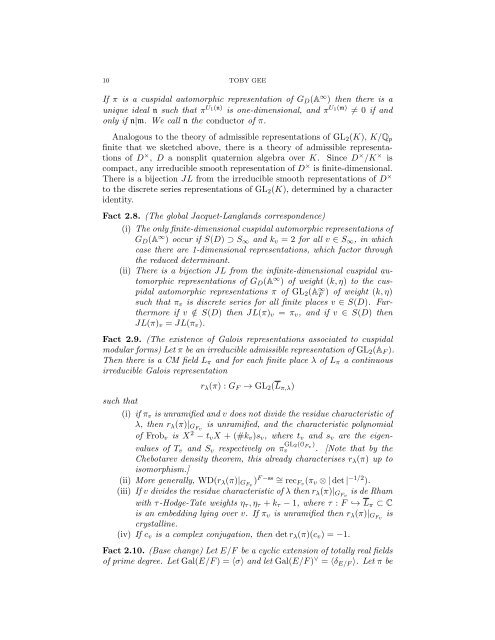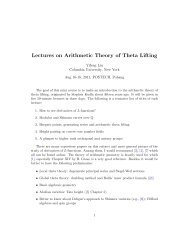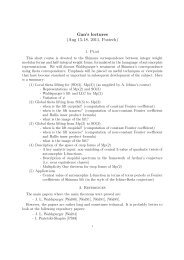MODULARITY LIFTING THEOREMS - NOTES FOR POSTECH ...
MODULARITY LIFTING THEOREMS - NOTES FOR POSTECH ...
MODULARITY LIFTING THEOREMS - NOTES FOR POSTECH ...
You also want an ePaper? Increase the reach of your titles
YUMPU automatically turns print PDFs into web optimized ePapers that Google loves.
10 TOBY GEE<br />
If π is a cuspidal automorphic representation of GD(A ∞ ) then there is a<br />
unique ideal n such that π U1(n) is one-dimensional, and π U1(m) �= 0 if and<br />
only if n|m. We call n the conductor of π.<br />
Analogous to the theory of admissible representations of GL2(K), K/Qp<br />
finite that we sketched above, there is a theory of admissible representations<br />
of D × , D a nonsplit quaternion algebra over K. Since D × /K × is<br />
compact, any irreducible smooth representation of D × is finite-dimensional.<br />
There is a bijection JL from the irreducible smooth representations of D ×<br />
to the discrete series representations of GL2(K), determined by a character<br />
identity.<br />
Fact 2.8. (The global Jacquet-Langlands correspondence)<br />
(i) The only finite-dimensional cuspidal automorphic representations of<br />
GD(A∞ ) occur if S(D) ⊃ S∞ and kv = 2 for all v ∈ S∞, in which<br />
case there are 1-dimensional representations, which factor through<br />
the reduced determinant.<br />
(ii) There is a bijection JL from the infinite-dimensional cuspidal automorphic<br />
representations of GD(A∞ ) of weight (k, η) to the cuspidal<br />
automorphic representations π of GL2(A∞ F ) of weight (k, η)<br />
such that πv is discrete series for all finite places v ∈ S(D). Furthermore<br />
if v /∈ S(D) then JL(π)v = πv, and if v ∈ S(D) then<br />
JL(π)v = JL(πv).<br />
Fact 2.9. (The existence of Galois representations associated to cuspidal<br />
modular forms) Let π be an irreducible admissible representation of GL2(AF ).<br />
Then there is a CM field Lπ and for each finite place λ of Lπ a continuous<br />
irreducible Galois representation<br />
such that<br />
rλ(π) : GF → GL2(Lπ,λ)<br />
(i) if πv is unramified and v does not divide the residue characteristic of<br />
λ, then rλ(π)|GFv is unramified, and the characteristic polynomial<br />
of Frobv is X2 − tvX + (#kv)sv, where tv and sv are the eigen-<br />
GL2(OFv )<br />
values of Tv and Sv respectively on πv . [Note that by the<br />
Chebotarev density theorem, this already characterises rλ(π) up to<br />
isomorphism.]<br />
(ii) More generally, WD(rλ(π)|GFv )F −ss ∼ = recFv(πv ⊗ | det | −1/2 ).<br />
(iii) If v divides the residue characteristic of λ then rλ(π)|GFv is de Rham<br />
with τ-Hodge-Tate weights ητ , ητ + kτ − 1, where τ : F ↩→ Lπ ⊂ C<br />
is an embedding lying over v. If πv is unramified then rλ(π)|GFv is<br />
crystalline.<br />
(iv) If cv is a complex conjugation, then det rλ(π)(cv) = −1.<br />
Fact 2.10. (Base change) Let E/F be a cyclic extension of totally real fields<br />
of prime degree. Let Gal(E/F ) = 〈σ〉 and let Gal(E/F ) ∨ = 〈δ E/F 〉. Let π be




